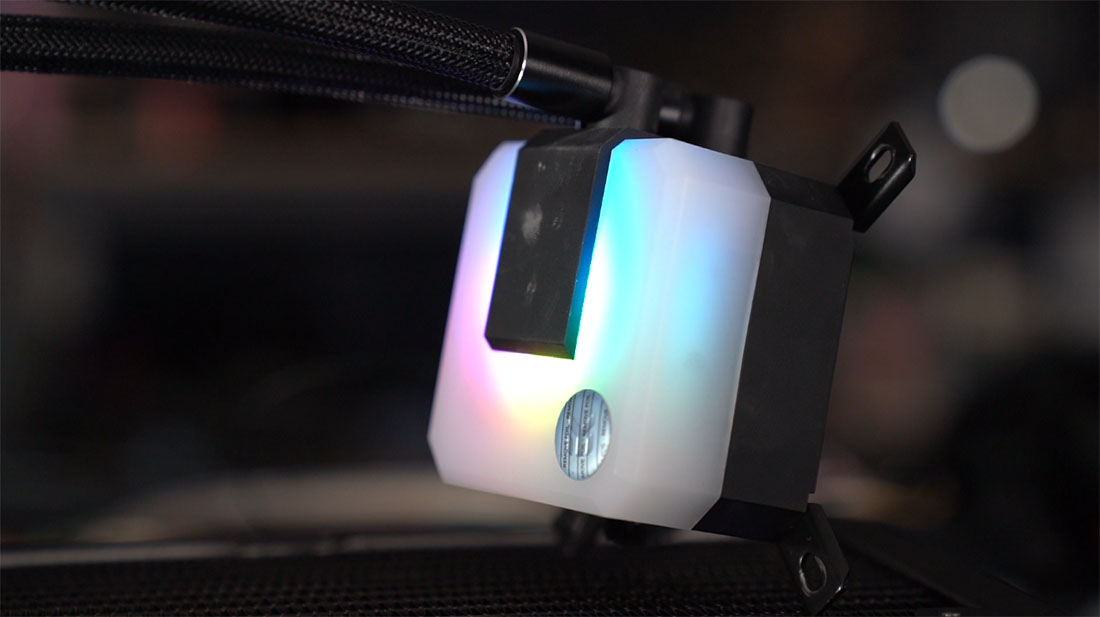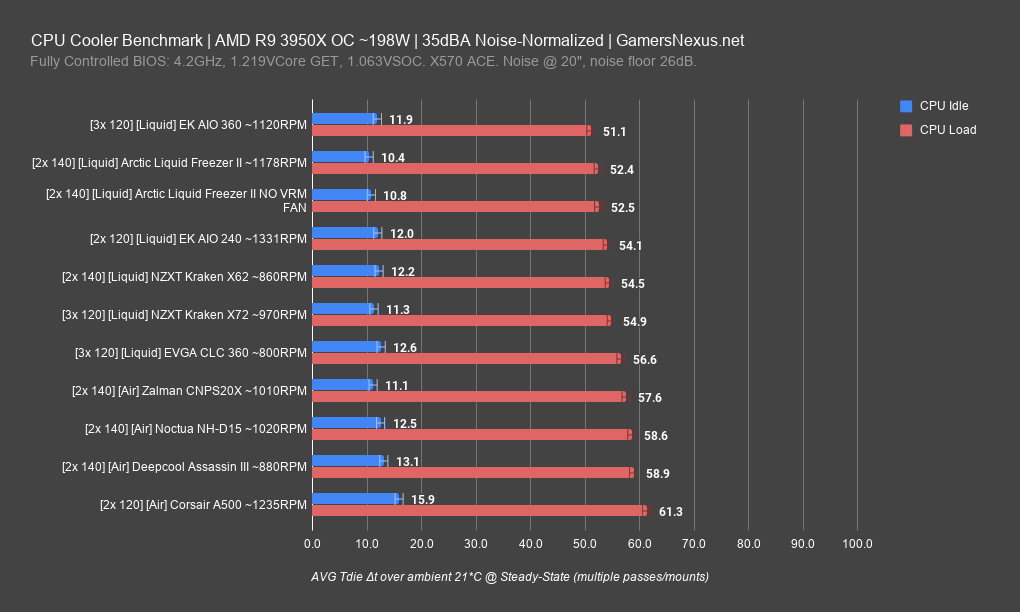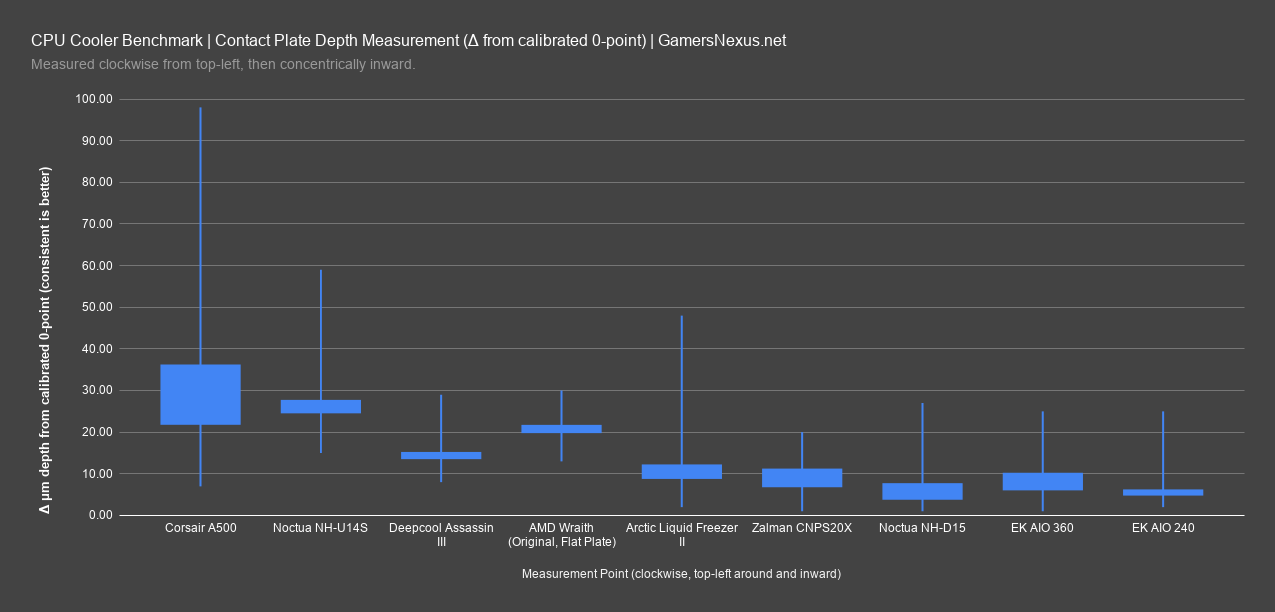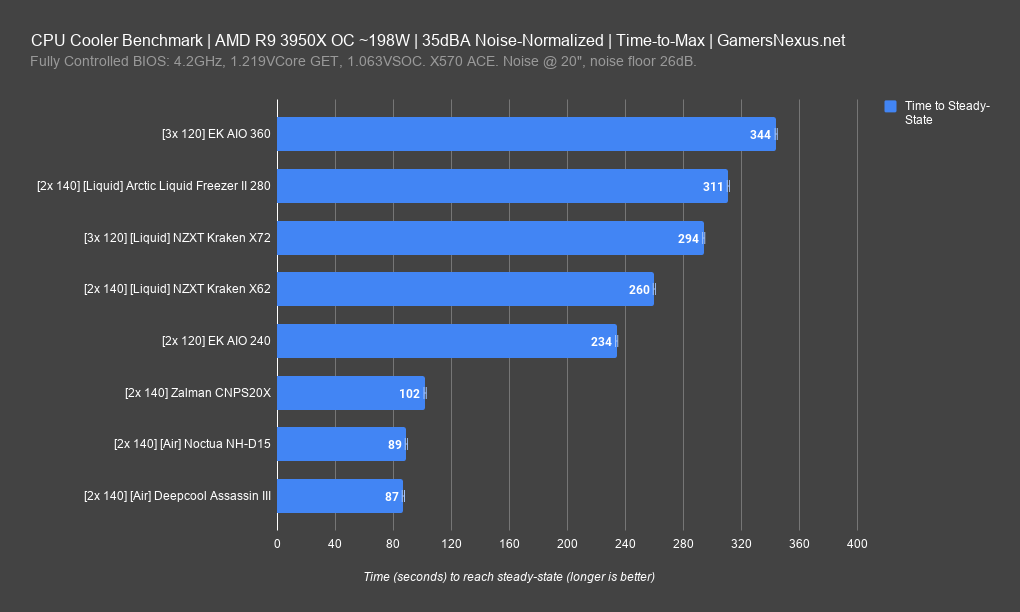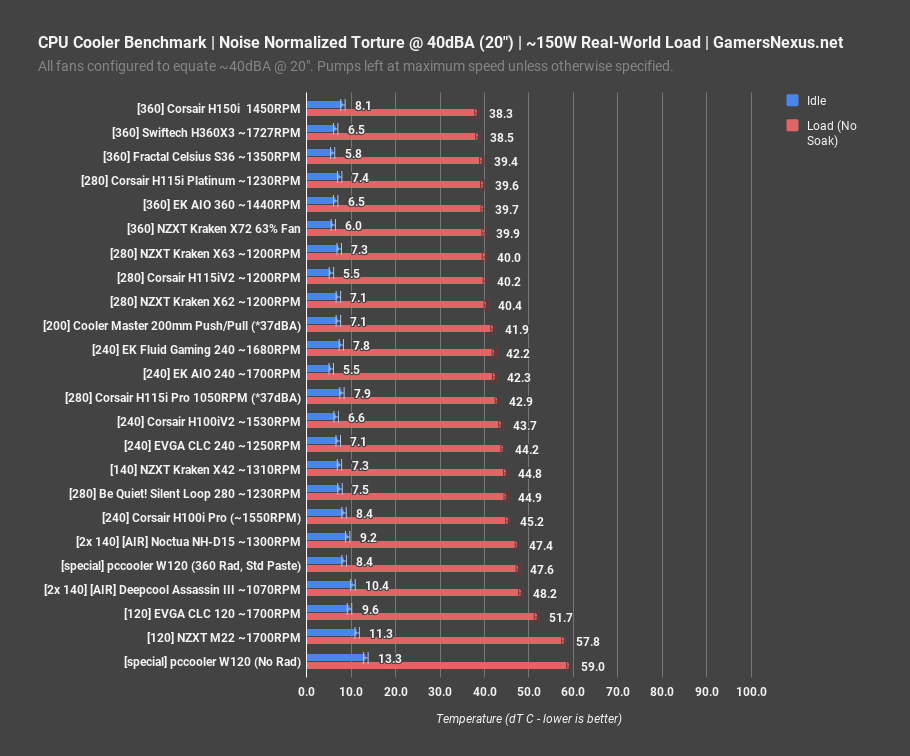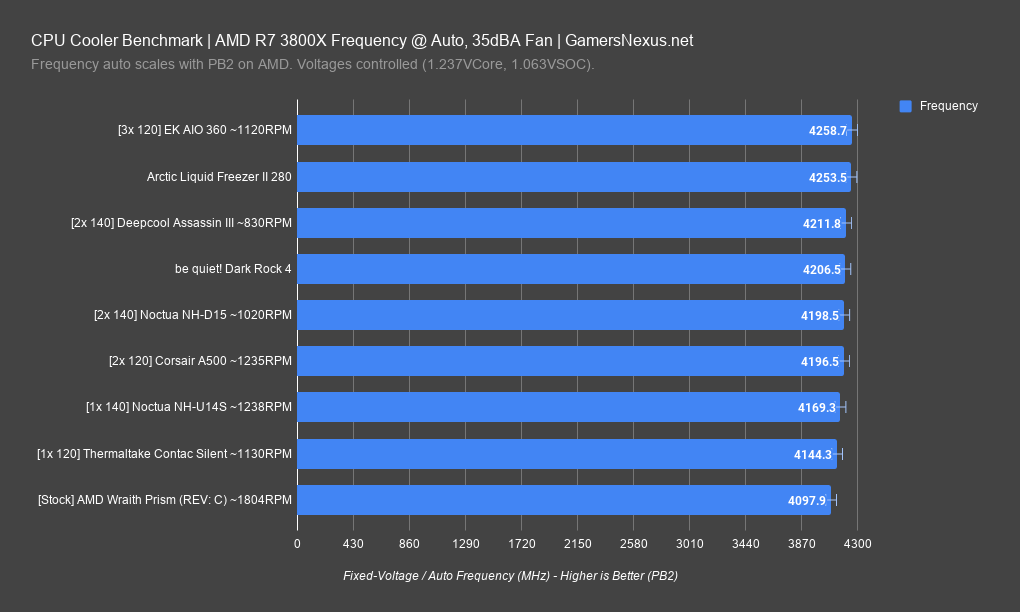EK AIO 360 & 240 D-RGB Cooler Review: Thermals, Noise, Coldplate Levelness
Posted on June 16, 2020
EK is best-known for its open-loop liquid cooling components, as we show at CES every year in the company’s bombastic display of systems, but that’s a small market, and EK has been trying to get into closed-loop liquid coolers for years. The EK AIO series is its newest attempt at that, but after facing one delay after another for shipping, it’s taken some time. Today, we’re reviewing the EK AIO 360 and 240 closed-loop liquid coolers for thermals, noise, noise-normalized thermals, coldplate levelness, efficacy on Intel and AMD platforms, and more.
EK’s AIO D-RGB series of coolers is a new approach to closed-loop liquid coolers from EK, most recently shown in public at CES 2020. Following that public update, the company encountered months of setbacks, but has finally reached the market with its new liquid coolers. Competition is fierce for CPU coolers right now, with Arctic’s Liquid Freezer II, which we reviewed here, posing the biggest challenge for EK.
Pricing for EK’s solution lands at $155 (via EK’s website) for the EK AIO D-RGB 360 and $120 for the AK EIO D-RGB 240. At time of writing, the Arctic Liquid Freezer II 280 is $95, but out of stock (at least via Amazon, and Newegg). It’s been mostly out of stock following positive reviews like ours, so although the LF II is directly competitive in price and performance (seen below), it’s somewhat moot if no one can buy it.
NOTE: This is a transcript of our video, for the most part, although the video has some more discussion in the intro and conclusion than found here. We publish these articles to be helpful, but make most our money to sustain this expensive operation via videos. If sharing the content, please consider sharing the video instead.
Marketing
We often talk about product marketing to set the tone for our review. EK’s marketing, overall, is rather technical and bland -- which is what we like. That means it’s probably more accurate, or at least less likely to talk about how it uses biomimetics and the silhouette of a spider to improve performance, or something.
EK mostly tries to leverage its open loop competence in marketing its CLC, appealing to authority in one space to try and establish a foothold in a newer one. This is a common strategy and, thus far, we haven’t read anything horribly out-of-line or overmarketed. They say that it’s a “pre-filled pump-res combo design for a liquid cooling solution that’s ready to go straight out of the box,” which is all accurate. The res is the tank on the radiator, the rest is obvious.
The only place EK deviates from the objective is to talk about its RGB lighting on the acrylic cover, claiming that it’s a “light diffuser with a frosted finish for a dynamic lighting display with smooth color transitions.” We think, frankly, it looks like it was made in someone’s shed on their 3D printer, but that’s not particularly relevant to its performance. We’ll let you judge the looks yourself.
EK also advertises compatibility with several pieces of fine bloatware from motherboard manufacturers, if ASUS, Gigabyte, MSI, and ASRock security liabilities are something you want to install on your system. The product page and marketing are boring, which is good, so we’ll move on. Nothing to nail them for here.
Product Internals
To briefly mention internals, we have a separate tear-down video coming up that’ll talk about how the EK AIO series works and how it’s assembled. The biggest item of note is that it’s running a larger diameter plastic impeller, as compared to the smaller Asetek CLC impellers or the medium-sized Arctic metal impeller. The EK AIO also uses a massive electromagnet for the pump, something we’ll look at in the tear-down.
Installation Procedure
The installation procedure is trivial with EK’s AIO series, as we’ve come to expect from most liquid coolers. It tends to be the air coolers, like Zalman’s CNPS20X and its abominable 26 screws to mount, where we see challenges in mounting hardware. Even Arctic’s was inconvenient and something the company is improving upon.
EK’s solution is simple: Two plates are attached to the pump block with four screws, so we’re at 6 parts that should probably be pre-installed for one of the two brands, but that’s not offensive. You next thread four standoffs into the AMD stock backplate, at 10 parts from EK, then drop some springs and hand-tightened cap screws into place. The springs mean no concern about mounting pressure is needed -- you just tighten within reason until sufficient resistance is provided, then stop. This helps standardize the mounting force and, therefore, the performance, but also reduces risk of users over-tightening, as can happen on Asetek products. That’s it. Easy enough process, and it’s the same between Intel and AMD, although obviously the spacing changes, and HEDT parts cut down to just the four standoffs without need of a backplate.
Testing Methodology
To learn about our test bench and testing procedures, please see our detailed testing methodology article or video.
AMD R9 3950X 35dBA
Our first chart looks at the more intensive 200W heat load, as produced by the 3 dies on the AMD 3950X. We’ve normalized the noise levels to 35dBA at 20” distance, creating an equal playing field to test the efficiency of the pumps, fans, and radiators without permitting the fans to just brute force performance at the expense of noise. Again, remember that we keep the included fans for this test.
In this test, the EK AIO 360 ends up a new chart leader, just ahead of the Arctic Liquid Freezer II 280mm CLC; note, however, that we don’t have the Liquid Freezer II 360 to test, so there’d be some competition size-for-size. The EK cooler is now the chart-topper and holds a technical victory over the rest of what we’ve tested thus far on AMD, so we’ll need to turn to our Intel HEDT bench soon to look at 3 years of CLC data. The EK AIO 240 runs at about 54 degrees over ambient in our testing, which ranks it functionally equivalent to the Kraken X62 280mm CLC with the older Asetek Gen5 pump, while the EVGA CLC 360 and Kraken X72 show poor static pressure performance at the restrictive noise levels we’ve set. They just can’t overcome the resistance with the noise-constrained RPM. The EK AIO 240 at $120 is worse value than the Arctic Liquid Freezer II 280 at its original $95, and the same goes for the EK AIO 360 at $155, despite its technical victory in noise-normalized performance.
VRM Thermals with 3950X
Our next thermal data considers the VRM temperature. This is most relevant for air coolers or for coolers like the Arctic unit, which has a VRM fan, but it’s still interesting for standard liquid coolers. Liquid coolers are mounted in an equivalent position to the top of a case, so this gives you a look at expected performance in an equivalent top-mount.
Likely unsurprisingly, the Liquid Freezer II remains the leader in VRM thermals at 35dBA. The NH-D15 is next, with the Liquid Freezer following that up with its VRM fan disabled -- the wider spread of the 140mm fans help get even spread across the VRM heatsinks. The EK AIO series follows that. The EK AIO 240 and 360 are within error and test variance of each other in all three MOSFET thermal measurements. Ultimately, this number doesn’t matter too much -- it’s a technical tally favoring large air coolers that cast air toward the VRM heatsinks, like the NH-D15, or toward the Arctic Liquid Freezer with a VRM fan; that said, considering we’re talking about parts that can run at 100C and technically still be fine, it’s something of a hollow victory under these testing conditions. Note that this chart becomes irrelevant if you mount your EK AIO in the front, as you’d be relying on case fans, at that point.
Coldplate Levelness
Our coldplate levelness test is next. For this one, we’re using specialized equipment for measuring the depth of the coldplate from a known 0-point, as tested with a needle that gauges the depth point-by-point on the coldplate. The depth is measured in microns, and the unachievable-but-ideal result would be that the depth is the same across the entire coldplate when mounted, ensuring flat contact. Note we specifically said “when mounted,” here, because there will be some warping of the plate to match the curvature of the IHS with some coolers.
The chart shows the maximum depth measured, the minimum, and quartile results in the box. The EK AIO 360 is comparable to the Noctua NH-D15 for point-to-point deviations across the surface, with an overall higher average depth from 0. The average ends up just under 10 microns, but more importantly, that number is consistent. Our greatest depth is 25 microns on both the 360 and 240 AIOs, with minimums at 1 and 2, respectively. The Corsair A500 has been the worst measured to-date, with the highest point-to-point variability and greatest excursions from the mean, at 98 microns max. That’s what contributed to its poor performance.
AMD R9 3950X 100% Speed
This next chart allows the fans to operate at full speed, so we’re now disregarding noise and allowing the cooler to show its full potential with stock fans. We ran an extra configuration for this one: The pre-applied paste on the EK AIO 360 measured almost identically to our standardized application and paste. For at least the AMD Ryzen IHS size, we’d say that EK’s pre-applied paste is fine, and that you should feel no quarrels with using it as-is.
The EK AIO 360 runs at 51.4dBA at 20” distance, led only by the EVGA CLC 360 cooler at 60.4dBA -- you can see how much the results change based on the noise level. The CLC 360 did horribly relative to its size in the 35dBA test, although it does comparatively better at 40dBA in our Intel HEDT testing, but it does maintain a lead at its deafening 60.4dBA 100% speeds. The most interesting data is the EK AIO 240, which manages to equal the Kraken X72 and outperform the Kraken X62. The Liquid Freezer II’s lower-ranking result is expected and, at its noise level of 42.5dBA, it is significantly more efficient and effective than either NZXT Kraken cooler and the EK AIO 240 at 46.6dBA. That said, the NZXT coolers and their older Asetek Gen5 design are starting to show their age. The Kraken X63 in our Intel HEDT bench testing didn’t make any thermal improvements in the pump, only in the fans, and so Asetek looks to be presently in a disadvantaged position versus newer designs. Turns out that suing all your competition out of the market only works for so long before it breeds necessity and innovation.
As for the air coolers, they’re within a few degrees and mostly doing fine while comprising the bottom half of the chart.
Time-to-Max
This chart shows the time required to reach the maximum temperature, or steady state, under a 200W load with a normalized 35dBA noise level. This mostly demonstrates the ability of liquid coolers to better soak large load spikes, offering the potential to keep thermally-dependent clocks -- like those operated under Precision Boost 2 or TVB -- at higher levels for longer. This chart is mostly a function of the size of the cooler. The EK AIO 360, unsurprisingly, outperforms the lot at 344 seconds until steady-state. Comparatively, the larger air coolers required between 87 and 102 seconds to reach steady state. The NZXT Kraken X72 360mm unit has again been exposed of an aging pump design and overall poor performance with these slower fan settings, falling behind the Arctic and EK units alike. The EK AIO 240 expectedly lands at the bottom of the liquid coolers and top of the air coolers.
Intel HEDT 40dBA Thermals
This next test is noise-normalized at 40dBA on an Intel HEDT CPU, our 3-year-old test bench, and is compared against more coolers. Note also that the fact that this is a monolothic, HEDT, large-area IHS has the potential to significantly shuffle some results. Testing at 40dBA also changes things, as now we’ve shifted in a way that the fans with worse static pressure performance may be able to achieve the minimum pressure required to cool efficiently, whereas 35dBA can fall below that threshold for inefficient fans.
And we see that materialize here: The EK AIO 360 is functionally equal to the NZXT Kraken X72, X63, and H115i Platinum. The other 360s, like the H150i and H360X3, end up charted ahead but within error. Everything we just named is within run-to-run variance or error, and so we can say they’re equal in this test environment. The EK AIO 240 falls closer to the EK Fluid Gaming 240 and older Corsair H100iV2.
AMD 3800X Auto Frequency
This chart removes the frequency control and makes it the variable instead, while still maintaining voltage controls and fan noise-level controls. That means we’re now looking at the maximum average all-core frequency permitted by the cooler, because Precision Boost 2 is variable contingent upon temperature. The EK AIO 360 leads the chart with a 5MHz boost over the Liquid Freezer II at the same noise level, or about 147MHz over what’s enabled by the big Deepcool cooler.
Conclusion
The EK AIO 360 & 240 have one of the best internal assemblies of a closed-loop liquid cooler that we’ve seen in a while, sans some concerns about an unclean radiator (see the video conclusion for discussion of this). The cooler is competitive in performance, but not in price, and so the rest will come down to looks. The Arctic Liquid Freezer II series makes more sense for AMD Ryzen CPUs, in the least, at its price-point -- but it also doesn’t run any RGB anything, and that may be a downside for some people. If that’s the case, EK has a technical chart-topping performance with the 360 model (or would at least be close enough that they’re functionally the same versus a 360 LF II), and so choices get narrowed-down to a black-out design versus an RGB design. In the subjective sense, we find EK’s block ugly, but that’s irrelevant if you like it.
We can’t judge endurance from a review period, so we’ll have to keep an eye on how these coolers develop over years of use to see how EK’s and Arctic’s designs really aged.
See the video conclusion for more discussion. It’s timestamped in the video description.
Editorial, Testing: Steve Burke
Video: Keegan Gallick, Andrew Coleman
